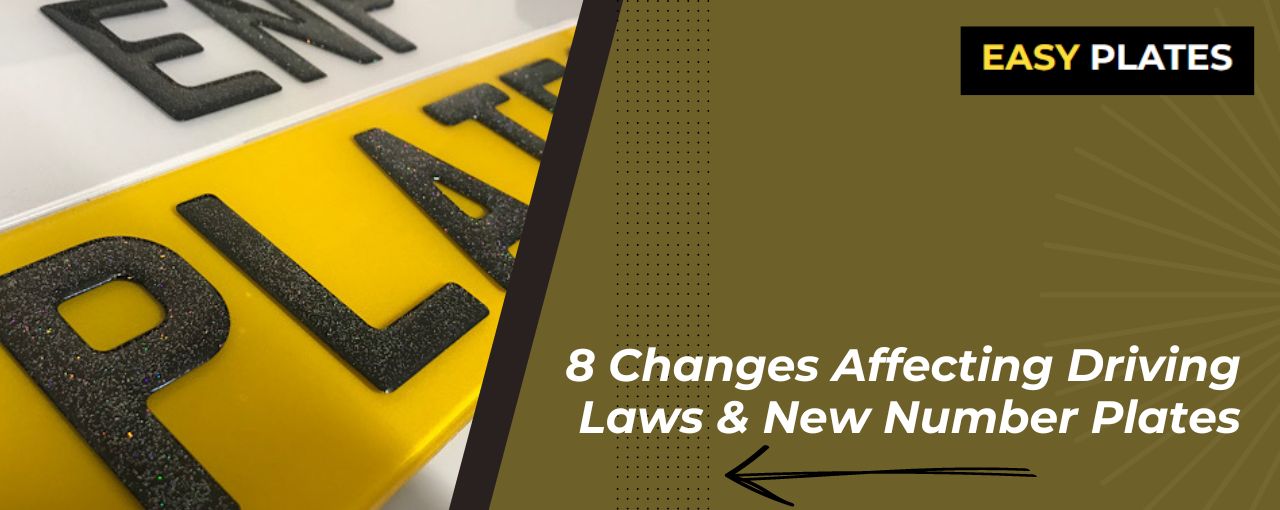Everything you need to know about number plates
A Guide to UK Number Plate Regulations
In recent years, the DVLA has introduced significant updates to UK number plate laws, covering aspects like the plate format, materials, and regional identifiers.
To ensure you’re compliant, we’ve compiled a comprehensive guide to UK number plate regulations, new rules, and their impact on vehicle owners.
What is a Registration Number?
A registration number is assigned to a vehicle during its registration and taxation process. Unlike a vehicle’s owner, this number stays with the vehicle until it’s scrapped, broken down, or permanently exported. However, the registered owner can apply to transfer the number to a different vehicle or retain it on a certificate (V778).
What are Number Plates?
Number plates, or licence plates, are attached to the front and rear of vehicles to display registration numbers for identification. In the UK, they have been mandatory since 1904 for most vehicles on public roads.
Two registration systems are in place for the UK: one for Great Britain (GB), managed by the DVLA, and one for Northern Ireland (NI), managed by the DVA. As of 28 September 2021, the identifier changed from GB to UK for both regions.
Changes in 2021 and 2022
After Brexit, new number plate designs and standards were introduced. From September 2021, the ‘BS AU 145e’ standard for retroreflective plates was enforced, requiring plates to be more durable with solid black lettering. This change aims to improve readability for ANPR cameras. Additionally, two-tone lettering that created 3D or 4D effects was banned, though Perspex or acrylic letters are still allowed if compliant.
In 2022, the DVLA mandated new plates to include identifiers like the supplier’s business name, postcode, plate manufacturer, and the new British Standard. Plates now feature the Union Jack instead of the EU flag and display ‘UK’ rather than ‘GB’ in line with Brexit.
How Do UK Number Plates Work?
The current number plate system uses a two-letter region code, a two-digit age identifier, and three random letters. For example, the ‘74’ plates issued on 1 September 2024 identify cars registered through 28 February 2025.
Older systems, such as ‘Suffix’ (1963-1982) and ‘Prefix’ (1983-2001), used single-letter age identifiers at the beginning or end of the plate.
Number Plate Rules
All UK number plates must meet the Road Vehicles (Display of Registration Marks) Regulations 2001 standards, which specify typeface, spacing, size, and colouring. Key rules include:
- Front plates with black characters on white; rear plates on yellow.
- Night illumination and a reflective background (classic cars are exempt).
- Solid black, non-reflective characters in the correct font and order.
- No bolts, fixings, or dirt obscuring characters.
- Supplier and British Standard markings (‘BS AU 145e’ for post-September 2021 plates).
Certain symbols, flags, and green flashes (for zero-emission vehicles) are allowed, but designs with italics, altered colours, or 4D fonts are illegal. Non-compliant plates can incur fines of up to £1,000 and fail MOT tests.
Regional Flags and National Identifiers
In England, Scotland, and Wales, number plates can include flags and identifiers such as:
- Union Flag, St George’s Cross, St Andrew’s Cross, or Red Dragon of Wales
- Identifiers like UK, GB, ENG, SCO, CYM, and others
Personalised Number Plates
Personalised plates allow vehicle owners to create unique displays with names, dates, or initials. Available through the DVLA or private dealers, they can be transferred between vehicles or retained on a certificate. When selling a vehicle, owners must apply to retain their plate if they want to keep it.
Motorcycles, Motor Tricycles, and Trailers
Motorcycles registered after 1 September 2001 need only a rear plate displayed over two lines, while those registered before this date may also have a front plate. Trailers must display the same plate as the towing vehicle, with additional rules for trailers taken abroad.
Green Number Plates
Since 2020, zero-emission vehicles can display a green badge on their number plates, symbolising environmental friendliness. Though optional, this badge is increasingly common among eco-conscious drivers.
Driving in the EU
UK number plates with the Union Flag and UK identifier don’t require additional UK stickers when driving in the EU. However, vehicles with GB identifiers, a Euro symbol, or any national flag may need a UK sticker, especially in Spain, Cyprus, and Malta. Driving without the UK identifier in Europe may result in fines.
Whether replacing an old plate or ordering a new one for a personalised registration, stay compliant with these guidelines to avoid penalties and ensure road safety. For more, see our comprehensive MOT checklist and guide.





